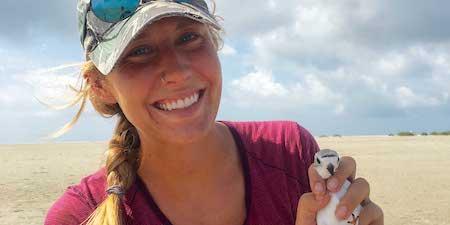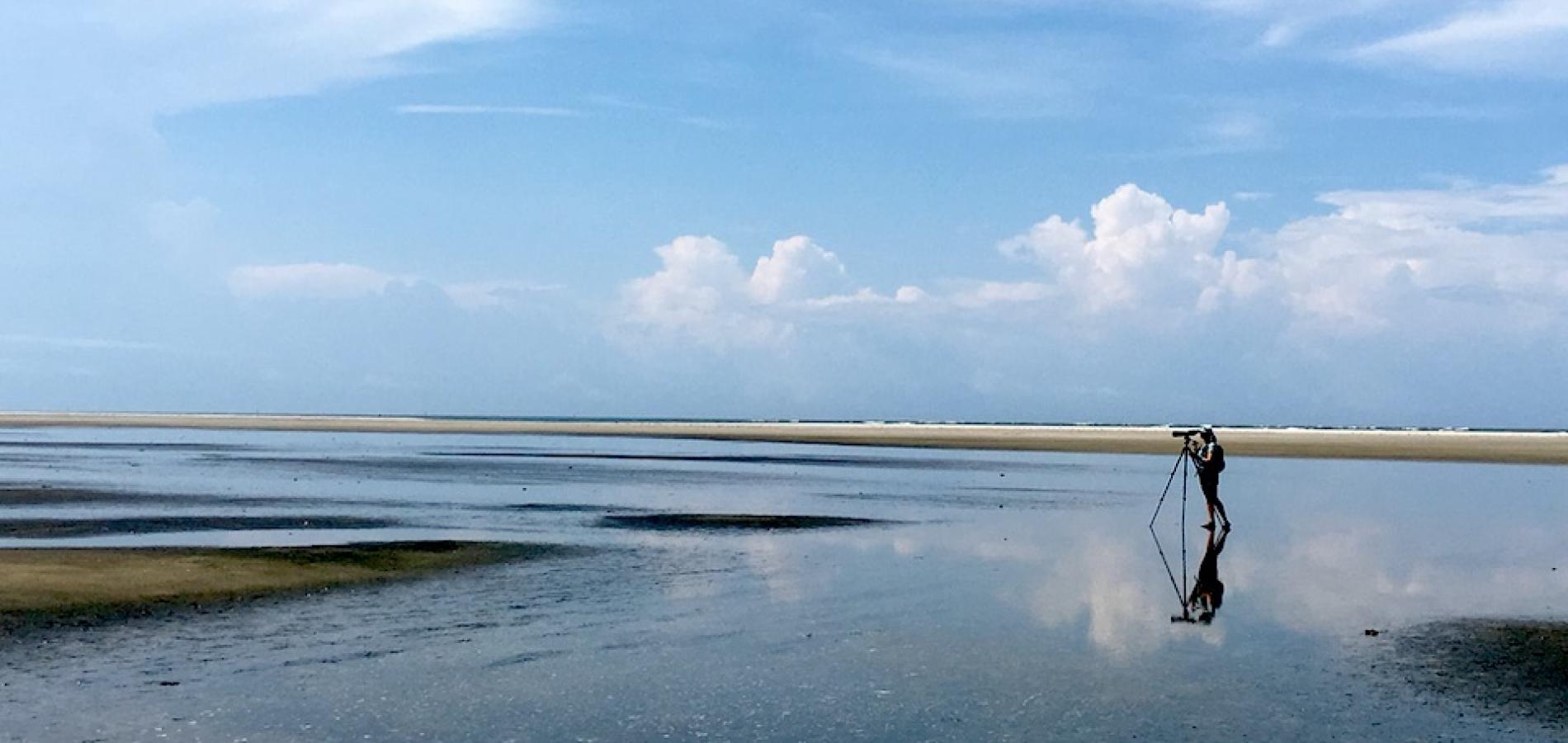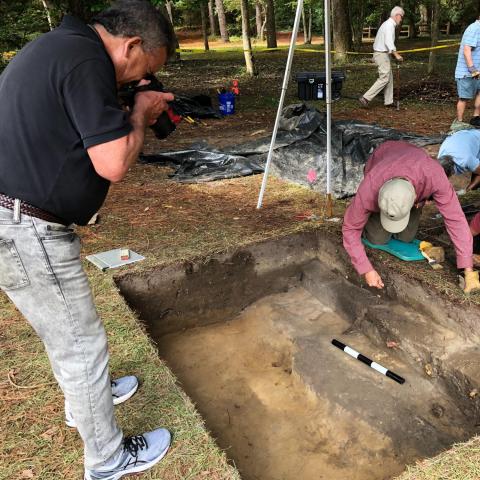There is on the sandy southern tip of Cape Hatteras National Seashore a rather nondescript club-shaped stretch of beach that in summer attracts an astonishing number of piping plovers that seemingly treat South Point as a last refueling stop of sorts before winging off to their wintering grounds.
If that fact alone doesn't seem particularly newsworthy, then consider that the hundreds of birds whose future is considered threatened under the Endangered Species Act flock to this seaside point on North Carolina's Outer Banks in the greatest concentration of migrating plovers ever recorded.
Indeed, the estimated 569 plovers that used South Point during the summer months of 2016 before heading further south represented not only roughly 15 percent of the Atlantic Coast plover population, but 10 percent of the global population of these diminutive shorebirds.
At a time when sea levels are rising due to climate change, when development is intruding on natural areas that wildlife depend upon, this discovery not only highlights the value of Cape Hatteras National Seashore to the plovers' future, but also underscores the role of the National Park System in toto to the health and future of flora and fauna.
“I think there are so many great stories to tell about migratory species, migratory corridors, landscape connectively, and the role that the Park Service plays in all that," Cape Hatteras Superintendent David Hallac said the other day during a phone conversation. "In my opinion, it’s some of the most important work that we do, connecting those gaps.
"It’s hard to find stories to show just how important those little pieces of land are, and this is one that really illustrates it," he went on. "I can almost see a sign there as these birds are flying down, that sign like you see, 'Last gas before bridge or before tunnel.' This is the last place for those birds to gas up and bulk up on food before they’re making a long flight. Because of that, this spot, while it might not be important for reproduction, it’s critical for a bird that has to fly somewhere. It’s a real important spot.”
While the national seashore staff knew anecdotally that plovers gathered in some rather large numbers at South Point, which stands on Ocracoke Inlet, it took Chelsea Weithman's field work as a master's student at Virginia Tech University to verify the significance of the area. That a congregation of nearly 600 piping plovers could be drawn to the area and few realized it likely is due to several factors, she said. While the species' threatened listing has prompted scrutiny of where they breed, there hasn't been a lot of attention to their migrations, said Weithman.
"They’re easy to find on the breeding grounds, where a lot of people are, but their wintering grounds and some of their migratory places are a lot more difficult to access," she said Monday. "They winter a lot more in the Caribbean. They have thousands of little keys and islands down there. We’re actually now, just in the last 10 or 15 years, just really starting to figure out where a lot of them go. I think until up until pretty recently there was an estimated third of the Atlantic Coast population that was 'missing' during the winter just because they can find a tiny little island, spit of sand, there one day gone the next, that people might not visit.”
The national seashore's role as a breeding grounds for plovers is well-documented in recent history. Its wide, sparkling beaches are popular with visitors of all kinds -- humans, birds, and reptiles included -- and that creates problems at times when some of the wildlife are protected by the Endangered Species Act.
An ongoing problem on Cape Hatteras, a stretch of barrier islands that the Atlantic Ocean constantly is redesigning, that results from the constant bulldozing of sand back into place is that wildlife habitat is lost to the pounding sea. The outcome is that human visitors, birds, and turtles are squeezed into the same shrinking places on the beach. And that has not always gone well.

Piping plovers long have been known to use Cape Hatteras National Seashore for breeding, but little was known about the seashore's role for migrating plovers. These small birds, lumped in size somewhere between sparrows and robins and weighing perhaps 2 ounces, winter in coastal Florida, along the Gulf Coast, the Bahamas, and the Caribbean /NPS
In a two-part series back in 2011, the Traveler looked at the intersection of plovers and humans on the national seashore. You can find the stories here and here. While the value of the national seashore for breeding shorebirds was made clear, no mention was made of its role for birds preparing to migrate, something Weithman's paper (which in March she successfully defended as her master's thesis) clearly defines.
"The plovers using South Point in 2016 were the largest group of plovers ever detected during migration. Use of this site for nearly a month or more suggests that South Point is a key stopover site for the species," states the paper for which Weithman was the lead author on a team with six others. "Given the large proportion of this species that may use this site annually, conditions at South Point during key stopover periods may have widespread effects on population dynamics of the Atlantic Coast population."
While previous reports had claimed plover congregations of maybe 100 individuals in any one place getting ready to migrate, Weithman's team documented 292 on one day (August 1, 2016), and an estimated 569 between July 3 and October 28 that year.
"South Point provided an important stopover location for an imperiled shorebird. The group of plovers that migrated through South Point in 2016 represents 14.7% of the Atlantic Coast breeding population, and 9.9% of the global breeding population," they noted. "Additionally, our peak estimate suggests that 7.5% of the Atlantic Coast population was present on South Point in a single day."
With Portsmouth Island, the northern point of Cape Lookout National Seashore, directly across the inlet from South Point, the researchers spotted piping plovers moving between the two beach lines, suggesting that that island could also be a valuable patch of beachfront for migrating plovers.

South Point at the southern-most point of Cape Hatteras National Seashore is a key staging point for migrating piping plovers, and Portsmouth Island at Cape Lookout National Seashore directly across from it to the south could be equally valuable/Google Earth
What draws the birds to these areas? The buffet under their feet and swirling about their beaks.
"We see them pulling marine worms, polycheates, a lot out of these muddy areas," Weithman said. "I think there’s probably a lot of very small invertebrate larvae. I’ve seen them take flies, the rare spider that they may see crawling across somewhere. They’ll definitely go after those guys. It seems like their treasured prey is these marine worms that they pull out from just under the sand. Whether that is a hot bed for them, we’re not really sure yet, but we know there’s -- by all the bug bites I get out there -- there’s definitely a lot of flies and other insects out there that they’re gleaning from the surface.”
What Weithman and her colleagues also discovered was that different segments of the Atlantic Coast piping plover population arrive at South Point at different times and stay for different periods of time. For example, birds from Delaware, Maryland, Virginia and North Carolina stayed 46 days at South Point, while those from coastal New York and New Jersey refueled in just 26 days. Why the difference is fodder for more research, she said.

Chelsea Weithman built her master's thesis around the role a section of Cape Hatteras National Seashore plays for migrating piping plovers.
Various factors could be influencing their use of South Point. Did the New York-New Jersey birds make additional stops on their way to the Outer Banks? Do the Delaware, Maryland, Virginia, and North Carolina birds migrate deeper into the Caribbean and so need to put on more calories before taking flight?
"I think understanding the particulars of how individuals and maybe groups of birds use this area, it might influence a lot of things, like their population growth in the recovering areas, in their breeding grounds along the Atlantic Coast," said Weithman.
Back at the national seashore, Superintendent Hallac reiterated the value of this research.
“I think one of the things that this does highlight is sometimes I believe that we thought that Cape Hatteras National Seashore was really critical for reproduction of shorebirds, particularly rare shorebirds. We thought it was a crucial area for nesting," he said. "And it is an important area for nesting. But I think what we’re learning from studies like Chelsea’s is that many areas of the seashore are even more important for the migration of these shorebirds as they move up and down the coast.
“I’ve been so excited by their findings. To think about hundreds of piping plovers representing 10 percent of the entire world’s breeding population? It’s really, really amazing.”





 Support Essential Coverage of Essential Places
Support Essential Coverage of Essential Places







Comments
"birds from Delaware, Maryland, Virginia and North Carolina stayed 46 days at South Point, while those from coastal New York and New Jersey refueled in just 26 days." Very interesting. At Cumberland Island National Seashore, GA, we have a lot or resights from NY, NJ and RI but virtually none from DE, MD,VA and NC! Your data suggest the latter group skip over coastal GA. What might we learn if more coastal states banded their breeding populations?
I did a backpacking trip on North Manitou Island in Lake Michigan, part of Sleeping Bear Dunes National Lakeshore. We did a beach-walk around the southern end of the island, but had to by-pass the very tip which is off-limts to protect the Piping Plover nesting area there. We are fortunate to have these National Seashores and Lakeshores to help these cute little guys.